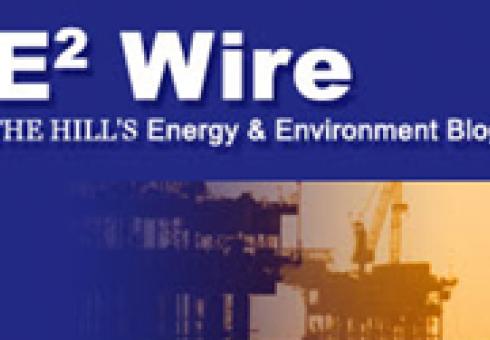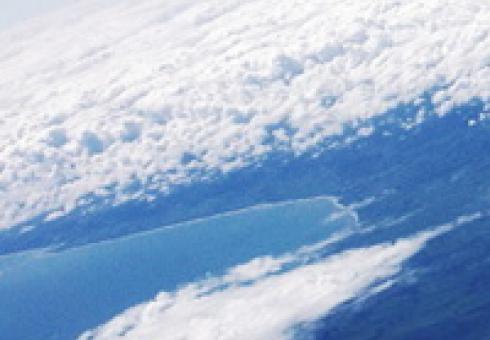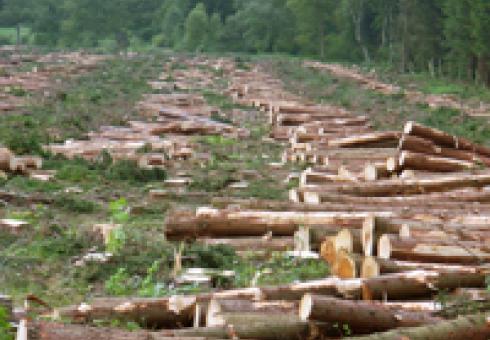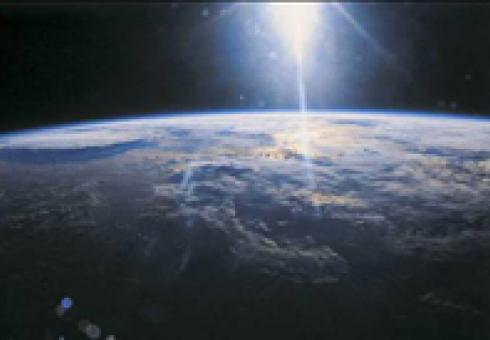News + Media
By Ari Natter
WASHINGTON, D.C.--A tax on carbon dioxide emissions could raise $1.5 trillion, according to a Massachusetts Institute of Technology report that said the revenue could be used to stave off budget cuts as Congress seeks to reduce a looming federal deficit.
The report, Carbon Tax Revenue and the Budget Deficit: A Win-Win-Win Solution?, released Aug. 27, examined the effects of a carbon tax starting at $20 per ton in 2013 and rising 4 percent annually.
According to the report, such a tax would cut carbon dioxide emissions 20 percent below 2006 levels by 2050, encourage the use of renewables, and reduce oil imports.
“Whether we cut taxes or maintain spending for social programs, the economy will be better off with the carbon tax than if we have to keep other taxes high or cut programs to [rein] in the deficit,” John Reilly, an author of the study and the co-director of MIT's Joint Program on the Science and Policy of Global Change, said in a statement.
Alternative to Tax Increases, Defense Cuts.
The report, which comes as Congress seeks ways to reduce the federal deficit, says the revenue provided through a carbon tax could provide an alternative to tax increases and cuts to defense spending and social programs, and could allow an extension of the Bush tax cuts that are due to expire at the end of 2012.
However, the report's authors warn that “while in principle it is possible to get very positive results from a carbon tax, in practice” it depends on the specific proposal.
One, the Managed Carbon Price Act of 2012 (H.R. 6338), introduced earlier in August by Rep. Jim McDermott (D-Wash.), would place a carbon tax on fossil fuels but would set aside most of the revenues to be refunded to consumers, with the remainder being used for deficit reduction (149 WCCR, 8/2/12).
Still, many analysts remain skeptical that Congress has the appetite to enact carbon tax legislation anytime soon.
Climate legislation that would have required mandatory cuts in greenhouse gas emissions passed the House in 2009, but the Senate version collapsed in 2010.
By: Brad Plumer
With the United States facing the expiration of a slew of tax cuts in 2013—the dread “fiscal cliff”—there has been plenty of interest in offbeat tax-reform proposals. And one idea that a few economists keep knocking around is a fee on carbon emissions. After all, if we need to raise revenue, why not just tax global-warming pollution?
A new paper from the MIT Global Change Institute lays out how a carbon tax might work in practice. The authors model what would happen if, this December, Congress enacted a small fee on carbon emissions to fend off a portion of the tax hikes and spending cuts that are scheduled to occur. The carbon tax would be levied directly on fossil fuels—on coal that comes out of the mine, say, or oil that’s shipped in from overseas—and would start at $20 per ton of carbon in 2013, rising 4 percent each year thereafter.
The authors, Sebastian Rausch and John M. Reilly, estimate that this tax would raise $1.5 trillion over the next 10 years. If that revenue were then used either to cut income taxes, reduce payroll taxes, or deflect cuts to social-spending programs, the MIT authors find, most Americans would be slightly better off than if Congress simply let the fiscal cliff hit, with the Bush tax cuts and payroll tax cuts expiring automatically. (Using the carbon tax in this way would lead to an 0.02 percent bump in consumption and leisure over time.)
Now, the betting line is that Congress will do something to avert the looming tax hikes and spending cuts, so this isn’t a terribly realistic scenario. Implementing a carbon tax next year would still hurt the economy—it would just hurt slightly less than the fiscal cliff. Still, the broader point of the MIT analysis is to suggest that a carbon tax could be a more economically beneficial way of raising revenue than, say, payroll or income taxes. So even if Congress waited until 2014 or 2015 or whenever the U.S. economy has recovered, replacing other taxes with a carbon tax could still provide a minor economic boost (see the first graph below).
A carbon fee usually gets criticized for hurting poorer Americans the most—they spend the biggest slice of their income on gasoline and other energy-intensive products, after all. But Rausch and Reilly found that a lot of the distributional effects depend on what Congress does with the revenue, as shown in the chart below:

CTCorp = carbon tax used to cut corporate tax rate, CTPersInc = carbon tax used to cut income tax rate, CTPayroll = carbon tax used to cut payroll taxes, CTTransfer = carbon tax used to bolster social welfare programs like Medicaid
The green line shows how different income groups would be affected in 2015 if the carbon tax was used to fend off cuts to social welfare programs like Medicaid. Lower-income Americans would benefit significantly, while wealthier Americans would take a small hit. By contrast, the red and blue lines show the effects if revenue from the carbon tax was used to cut the corporate tax or personal income tax—in those cases, higher-income Americans would come out ahead. If, however, a carbon tax was used to cut payroll taxes—that’s the black line—then the welfare effects in 2015 are more or less neutral.
The MIT report argues that a carbon tax would accomplish a few other things as well. Fossil-fuel use would go down, oil imports would shrink slightly, and U.S. carbon-dioxide emissions would decline. On that last point, however, it’s worth noting that the carbon tax proposed by the MIT study only gets the United States a fraction of the way toward its long-term climate targets, as shown in this graph:

Blue line: MIT reference case with no carbon tax. Black line: EIA reference. Green line: Scenario with MIT carbon tax in place.
With the carbon tax proposed by MIT (that’s the green line in the chart above), U.S. emissions would be 14 percent below 2006 levels by 2020 and 20 percent below 2006 levels by 2050. That’s lower than if there was no carbon tax at all.
Yet the United States would still fall short of its long-term climate goals, which involve an 80 percent cut in emissions below 1990 levels by mid-century. According to MIT calculations, a modest carbon tax, on its own, wouldn’t get the United States close to that longer-term mark. It might make sense as a more economically efficient way of raising revenue. But the tax would either have to be hiked dramatically or combined with other clean-energy measures in order to make a significant dent in tackling global warming.
MIT researchers show a carbon tax could help raise the money needed to slash the deficit, improve the economy and secure America’s clean energy future.
By: Zack Colman
Taxing carbon would generate $1.5 trillion, potentially giving politicians cover from making politically difficult decisions on taxes and social spending cuts, according to a study by the Massachusetts Institute of Technology (MIT) released Monday.
A carbon tax would take pressure off Congress to find “tradeoffs” between closing the deficit gap and reviving the economy, according to John Reilly, an author of the study.
“Congress will face many difficult tradeoffs in stimulating the economy and job growth while reducing the deficit,” Reilly, the co-director of MIT’s Joint Program on the Science and Policy of Global Change, said in a statement.
“But with the carbon tax there are virtually no serious tradeoffs. Our analysis shows the overall economy improves, taxes are lower and pollution emissions are reduced.”
The study found that taxing carbon at $20 per ton would generate $1.5 trillion in revenue in a 10-year period. That could be used to reduce corporate and personal income taxes and maintain social services spending, all while reducing the deficit.
The study said the carbon tax also would lower pollution by 20 percent by 2050, compared with 2006 levels, and prevents oil imports from rising. It would also shift energy markets to clean technology, a sector to which the United States has already devoted much capital, the report said.
Sebastian Rausch, an assistant professor of energy economics at ETH Zurich, co-authored the study with Reilly. The study assumed full employment and was based on an earlier Congressional Budget Office report that used a $20-per-ton carbon tax.
Conservatives and liberals alike have recently explored the possibility of a carbon tax.
Right-leaning think tank the American Enterprise Institute (AEI) hosted informal discussions on the topic in July. GOP leadership, however, firmly dismissed the idea of a carbon tax following reports about the AEI talks.
Rep. Jim McDermott (D-Wash.) introduced carbon tax legislation in August, the revenue from which would be used to pay down the deficit and to offset cost increases. That proposal largely mirrors one from Sens. Maria Cantwell (D-Wash.) and Susan Collins (R-Maine).
In a study published online by the journal Science, Harvard University scientists reported that some storms send water vapor miles into the stratosphere — which is normally drier than a desert — and showed how such events could rapidly set off ozone-destroying reactions with chemicals that remain in the atmosphere from CFCs, refrigerant gases that are now banned.

The risk of ozone damage, scientists said, could increase if global warming leads to more such storms.
“It’s the union between ozone loss and climate change that is really at the heart of this,” said James G. Anderson, an atmospheric scientist and the lead author of the study.
For years, Dr. Anderson said, he and other atmospheric scientists were careful to keep the two concepts separate. “Now, they’re intimately connected,” he said.
Ozone helps shield people, animals and crops from damaging ultraviolet rays from the sun. Much of the concern about the ozone layer has focused on Antarctica, where a seasonal hole, or thinning, has been seen for two decades, and the Arctic, where a hole was observed last year. But those regions have almost no population.
A thinning of the ozone layer over the United States during summers could mean an increase in ultraviolet exposure for millions of people and a rise in the incidence of skin cancer, the researchers said.
The findings were based on sound science, Dr. Anderson and other experts said, but much more research is needed, including direct measurements in the stratosphere in areas where water vapor was present after storms.
“This problem now is of deep concern to me,” Dr. Anderson said. “I never would have suspected this.”
While there is conclusive evidence that strong warm-weather storms have sent water vapor as high as 12 miles — through a process called convective injection — and while climate scientists say one effect of global warming is an increase in the intensity and frequency of storms, it is not yet clear whether the number of such injection events will rise.
“Nobody understands why this convection can penetrate as deeply as it does,” said Dr. Anderson, who has studied the atmosphere for four decades.
Mario J. Molina, a co-recipient of a Nobel Prize for research in the 1970s that uncovered the link between CFCs and damage to the ozone layer, said the study added “one more worry to the changes that society’s making to the chemical composition of the atmosphere.” Dr. Molina, who was not involved in the work, said the concern was “significant ozone depletion at latitudes where there is a lot of population, in contrast to over the poles.”
The study, which was financed by the National Aeronautics and Space Administration, focused on the United States because that is where the data was collected. But the researchers pointed out that similar conditions could exist at other midlatitude regions.
Ralph J. Cicerone, an atmospheric scientist and the president of the National Academy of Sciences, who reviewed the study for Science, also called for more research. “One of the really solid parts of this paper is that they’ve taken the chemistry that we know from other atmospheric experiments and lab experiments and put that in the picture,” he said. “The thing to do is do field work now — measure moisture amounts and whether there is any impact around it.”
“The connection with future climate is the most important issue,” Dr. Cicerone said.
Large thunderstorms of the type that occur from the Rockies to the East Coast and over the Atlantic Ocean produce updrafts, as warm moist air accelerates upward and condenses, releasing more heat. In most cases, the updrafts stop at a boundary layer between the lower atmosphere and the stratosphere called the tropopause, often producing flat-topped clouds that resemble anvils. But if there is enough energy in a storm, the updraft can continue on its own momentum, punching through the tropopause and entering the stratosphere, said Kerry Emanuel, an atmospheric scientist at the Massachusetts Institute of Technology.
When Dr. Anderson produced data about five years ago clearly showing these strong injections of water vapor, “I didn’t believe it at first,” Dr. Emanuel said. “But we’ve come to see that the evidence is pretty strong that we do get them.”
At the same time, he added, “we don’t really understand what determines the potential for convection in the atmosphere,” so it is difficult to say what the effect of climate change will be.
“We’re much further along on understanding how hurricanes respond to climate change than normal storms,” Dr. Emanuel said.
The use of CFCs, or chlorofluorocarbons, was phased out beginning in the late 1980s with the signing of an international treaty called the Montreal Protocol, but it will take decades for them to be cleansed fully from the atmosphere. It is chlorine from the CFCs that ultimately destroys ozone, upsetting what is normally a balanced system of ozone creation and decay. The chlorine has to undergo a chemical shift in the presence of sunlight that makes it more reactive, and this shift is sensitive to temperature.
Dr. Anderson and his colleagues found that a significant concentration of water vapor raises the air temperature enough in the immediate vicinity to allow the chemical shift, and the ozone-destroying process, to proceed rapidly.
“The rate of these reactions was shocking to us,” Dr. Anderson said. “It’s chemistry that was sitting there, waiting to be revealed.”
Dr. Anderson said that if climate change related to emissions of greenhouse gases like carbon dioxide and methane led to more events in which water was injected well into the stratosphere, the effect on ozone could not be halted because the chemistry would continue. “It’s irreversible,” he said.
If CFCs had not been banned, the ozone layer would be in far worse shape than it is. But by showing that CFC-related ozone destruction can occur in conditions other than the cold ones at the poles, the study suggests that the full recovery of the ozone layer may be further off than previously considered.
“The world said, ‘Oh, we’ve controlled the source of CFCs; we can move on to something else,’ ” Dr. Anderson said. “But the destruction of ozone is far more sensitive to water vapor and temperature.”
The inescapable importance of China to global energy and climate efforts has compelled the Joint Program—in collaboration with Tsinghua University—to launch a special research effort called the China Energy and Climate Project.
A growing population and rapid development will put a strain on land used to grow food over this century. But if reforestation is used to avoid climate change it will create further strain, says a new MIT study.
It’s no surprise that the United States and China are the world’s top  greenhouse-gas emitters. What may be surprising is the country that ranks third in the lineup: Indonesia. Indonesia is a major culprit not because of its traffic or power plants, but because of its massive deforestation.
greenhouse-gas emitters. What may be surprising is the country that ranks third in the lineup: Indonesia. Indonesia is a major culprit not because of its traffic or power plants, but because of its massive deforestation.
Deforestation accounts for almost 20 percent of global emissions—more than the world’s entire transportation sector. But saving the trees—as beneficial as it would be to the changing climate — comes at a significant cost as a growing, wealthier population competes for food, says a new MIT study.
“With a larger and wealthier population, both energy and food demand will grow,” says John Reilly, the lead author of the study and the co-director of the MIT Joint Program on the Science and Policy of Global Change. “Absent controls on greenhouse gases, we will see more emissions from fossil-fuel use and from land-use change. The resulting environmental change can reduce crop yields, and require even more land for crops. So this could become a vicious circle.”
The Reilly et al. study, recently published in Environmental Science & Technology, compares the effects of slashing emissions from energy sources alone to a strategy that also incorporates emissions associated with land use.
The report finds that, with a growing global population, fast-developing nations, and increasing agricultural productivity and energy use, the world is on the path to seeing average temperatures rise by as much as 6 degrees Celsius by the end of the century. Even with an aggressive global tax on energy emissions, the planet will not be able to limit this warming to 2 degrees Celsius—the target world leaders have agreed is needed to avoid dangerous climate change. But when the tax is applied to land-use emissions, the world community could come much closer, with temperatures by the year 2100 rising 2.4 degrees Celsius above pre-industrial levels.
To go one step further in reducing emissions the study incorporates biofuels production, which could increase carbon storage on land and be a cleaner source of energy, lessening the use of fossil fuels. The researchers find that increased biofuels production could cut fossil-fuel use in half by the end of the century—from 80 percent of energy without a tax to 40 percent with a tax—and further limit warming to bring the world just shy of the target.
The world could get even closer to the target, the study shows, by creating economic incentives for storing carbon on land—such as through reforestation. In combination with the global carbon tax, this could “bring the world closer to keeping warming below the 2 degree Celsius temperature,” Reilly says.
But there are always drawbacks.
“The environmental change avoided by reducing greenhouse-gas emissions is substantial and actually means less land used for crops,” Reilly says. “The big tradeoff is that diverting this amount of land to carbon storage, and using land to produce biofuels, leads to substantial rises in food and forestry prices.”
Food prices could rise more than 80 percent, the study shows. Along with this, nations could become wealthier, with global GDP increasing fivefold. On average, the share of a household’s budget for food, even with higher prices, might fall from 15 percent to 7 percent. But for poorer regions of the world, the food budget share could increase, meaning these food price impacts could have disproportionate effects on poorer regions.
Food shortages and higher food prices are becoming a major challenge, according to Jonathan Foley, director of the University of Minnesota’s Institute on the Environment, who spoke at a recent MIT event.
“In the last 20 years we’ve produced 28 percent more crops. But in the next 38 years, we need to double that growth,” Foley said. “We’re not going to grow our way out of the problem … we must look at other possibilities.”
An advocate of ending deforestation, Foley said we need to grow food more efficiently.
Reilly agrees, and says his study puts an emphasis on more effective use of land to produce food. Part of this means more efficient (intensive) use of pasture and grazing land. But, he says, the carbon tax scenarios he tests make the problem that much more difficult—with biofuels and carbon sequestration using up more land.
“And with all three of these demands for land—food, biofuels and carbon storage—the competition is intense, and as a result, food prices rise. So this is an important tradeoff the world needs to consider.”
By Eric Niiler
As world leaders gather to assess the planet's health, most reports are gloomy, save for a couple bits of good news.
The world's political and environmental leaders gather in Rio de Janeiro tomorrow to assess the state of the planet's health 20 years after the first such gathering in 1992. But if science is any guide, Earth still needs some help.
Several new climate studies reveal various aspects of the same foreboding problem: the atmosphere continues to warm, glaciers continue melting and seas keep rising.
But there is a tiny bit of good news -- the United States and Europe have been able to cut their heat-trapping industrial emissions by switching to less-polluting natural gas, driving fewer miles and of course, sinking into an economic recession where fewer factories are working across much of the globe.
And while North America's mild winter, warm spring and, in some areas, hot June can't be blamed on global climate change, extreme weather events do grab the public's attention. Even though it's not entirely accurate to link climate and weather, perhaps that's not a bad thing, says Gavin Schmidt, a climate researcher at NASA's Goddard Space Science Center in New York.
"People spend a lot of time talking about the weather and love to do so," Schmidt said. "It's an odd thing because as scientists we are using people's interest in weather and weather extremes to talk about something that is connected, but isn't quite the same."
Schmidt said that rather than focusing on extreme blips in weather, it's instead important to look at changes in temperature over the long term. Scientists at the National Oceanic and Atmospheric Administration are doing just that, and reported that the past 12 months from June 2011 to May 2012 were the hottest since record-keeping began in the 1880s. The month of May 2012 was the second-hottest on record (2010 was first). And it looks like 2012 will barge into the top three hottest calendar years on record as well.
At the same time, there is occasional "noise" in the Earth's climate system, explained Ronald Prinn, professor of atmospheric sciences at the Massachusetts Institute of Technology. That means that the linear warming trend could stagger a bit from year-to-year, or decade-to-decade depending on the cooling effects of cloud cover or the ocean's ability to soak up heat.
"If you take a 10-year running average," Prinn told Discovery News. "It's clear that world has been warming for a hundred-plus years."
Some climate skeptics have pointed to the world's forests as a likely carbon "sink" that could suck up heat-trapping carbon dioxide, methane and other such gasses from burning fossil fuels. But a new study by researchers in California found that scenario might not be so simple.
As soil warms up, they found, it releases carbon dioxide made from microbes that decompose dead leaves and fallen trees. About one-third of that release comes from older soil, more than 10 years old.
"While that older material is not going to decompose really fast, there's an awful lot of it," Susan Trumbore, a University of California, Irvine, scientist who led the study, told The Washington Post.
That means that at some point in the future, the world's temperate forests could switch from a carbon sink to a carbon faucet, increasing the vicious cycle of rising CO2 causing even more CO2 to be released.
Another new study finds that Chinese officials may be cooking the books when it comes to carbon emissions.
United Kingdom-based researchers found the gap between what Chinese state authorities report as the nation's industrial emissions and the aggregate of provincial reporting has widened to 1.4 gigatons, that's about 5 percent of the world's entire CO2 emissions budget. Local officials may be padding the books to show more industrial output, while national authorities want to appear more environmentally-friendly to the West.
Either way, the new figures wipe out any gains elsewhere.
"The trends are pretty bad," Schmidt said. "All of the flattening in Europe and the U.S. are being more than matched by increases in China and India."
Despite the recent gloomy news, experts say there are solutions: replacing individual dung-burning stoves in Chinese homes with more efficient centralized power plants; developing more efficient cars, homes and light bulbs in the West; and continuing to shift away from coal as a prime energy source in both the United States and China.
"Nobody wants (another recession) as a solution to the climate issue," Prinn said. "We don't want to be hurting our economies. We need to develop new energy sources."
Unless the world gets a handle on its fossil fuel habit, experts say there's likely to be more extreme events like floods, droughts, heat waves and tropical storms.
"Without climate change we would be seeing extreme heat waves once every 100 years, now it's more on the order of 10 times in 100 years," Schmidt said. "That's going to increase. The dice are loaded, and we're loading them even more."
NREL-MIT study shows an 80 percent renewable energy standard cuts water use in half.
In his first State of the Union address, President Barack Obama set a goal for 80 percent of America's electricity to come from clean energy. Last week, the release of the Renewable Electricity Future study by the U.S. National Renewable Energy Laboratory (NREL) confirms that reaching this goal by 2050 is very possible. But what impact would clean energy have on another key ingredient to daily life: clean water? Researchers at MIT helped answer that question in NREL's report.
The MIT research—Modeling Water Withdrawal and Consumption for Electricity Generation in the United States—is a compilation of the water segment of the Renewable Electricity Future study. In it, the researchers find that as solar panels, wind turbines and other sources of non-thermal renewable energy replace coal, gas and similar thermal powerplants, the use of water to cool those powerplants will decrease by about half.
"The most important use of water for electricity production is for cooling," says Adam Schlosser, an author of the study and the assistant director for science research at MIT's Joint Program on the Science and Policy of Global Change. "The benefit of renewables like wind or solar is that you don't need to boil water for steam to spin the turbines, and then you don't need water to cool the steam. That cooling process is removed, saving a lot of water."
This is good news for water-stressed regions, including much of the western United States, as production of electrical power results in one of the largest uses of water in the nation. A 2005 report by the U.S. Geological Survey found that about 201,000 million gallons of water each day were used to produce electricity, with much of this water going toward keeping powerplants cool.
While most Americans will use less water when powering their homes with renewable energy, the MIT researchers did find that areas that switch to thermal renewable technologies might end up using more water. Biomass energy, being produced mostly in the northwestern United States, is one strong example, the study finds.
"Biomass is obviously contributing to the carbon aspect of the overall problem," Schlosser says, "But it's actually exacerbating an already water-stressed situation because you not only need water to grow it, you also need water to cool the thermal electricity generation process."
Schlosser compares this to concentrated solar technology being used in the southwest, which typically relies on a dry cooling system where fans are used instead of water.
"Solar technology really benefits the southwest because it uses a resource that's so plentiful in that region—the sun—and doesn't use a resource that there is very little of—water," Schlosser says.
But Schlosser explains that the dry cooling technology—while an obvious choice for the drought-stricken southwestern United States because it uses 90 percent less water—is less efficient and more expensive because the electric plant would need to use electricity to run large fans that force air through the heat-exchange process. This explains why areas where water scarcity is more subtle would choose to stick to water cooling technologies in thermal electricity generation.
Along with using less water, the Renewable Electricity Future study finds that greenhouse gas emissions would be reduced by about 80 percent, potentially offering significant public health benefits. The National Research Council estimated that in 2005, air pollution emissions from coal powerplants cost $32 per megawatt of energy in public health damages, the report notes, suggesting that the health cost benefits could counterbalance the costs to build clean energy infrastructure.
RELATED - Union of Concerned Scientists Webinar
Three Questions with Research Scientist Sebastian Rausch
MIT Joint Program on the Science and Policy of Global Change co-director and TEPCO professor of atmospheric science Ron Prinn was recently interviewed on his latest publication released today in the Proceedings of the National Academy of Sciences. The report, “Development and Application of Earth System Models,” focuses on the importance of Earth System Models in studying climate change. It is based on a lecture Prinn gave at the National Academy of Sciences Sackler Colloquium last year (watch the speech here).
Below is a transcript of the interview:
Q: Why do we need Earth System Models?
A: In laboratory science, we have the luxury of running “control” experiments in which selected conditions that would otherwise influence the “main” experiment are omitted. In the case of our environment, the influencing conditions come from humans. Because we do not have another earth without human influence to serve as a “control,” we often cannot directly measure the impacts of human development on the environment. So we form computer models of the combined natural and human systems, compare the models with observations, and then apply the models as “numerical control” experiments. Our specific earth system model – MIT’s Integrated Global System Model (IGSM) – is so unique because it combines the human system with the natural system to see how the two systems impact each other for the purpose of improving our understanding of both systems and informing policy decisions. The IGSM is in fact a “framework” of linked sub-models of varying complexity with the choice of the sub-models being governed by the issues being addressed; uncertainty studies dictate use of the most computationally efficient models, whereas studies of specific scenarios allow use of the more complex but computationally demanding sub-models.
Q: What is the value of integrated Earth System Models like the IGSM, as opposed to other approaches, for those making decisions about climate mitigation and adaptation?
A: Applied, for example, to the climate issue, the IGSM framework allows us to determine, in a self-consistent way, the probabilities of various amounts of climate change, the relationship between greenhouse gas reduction targets and temperature changes, and the uncertainty in the costs of various proposed policies. The IGSM framework also enables integrated assessments of the economic and environmental implications of proposed new low emission energy technologies. In making these analyses, we are able to help decision-makers compare the value of various mitigation policies, energy technologies, and adaptation strategies in lowering the risks to society. We can also assess the costs for stabilization of greenhouse gases at various levels, and how these costs can be justified by the expected benefits from the avoided damages.
Q: What can the MIT IGSM tell us about our climate and energy future?
A: In this paper, I outline just some of the ways we’ve used the full IGSM framework, or the relevant parts of it, in the past. These uses include the examination of the effect of different greenhouse gas stabilization targets on forecasts of the odds of various amounts of temperature, precipitation, sea-level, and sea-ice change, and of the costs of these stabilization policies. Also, the relationship between stabilization targets and the future loss of the ability of the oceans to slow warming by absorbing heat and carbon dioxide has been examined. The Kyoto Protocol uses a CO2-only strategy to reduce emissions, and our work with the IGSM shows that a multi-gas control strategy greatly reduces the costs of fulfilling the Kyoto Protocol with little difference between the two strategies in mitigating climate and ecosystem impacts. Assessments of the substantial impact of air pollution on human health costs and carbon uptake by land vegetation have been investigated. Another example stems from our work in examining the consequences of renewable energy at large scales – like wind power and bio-fuels. Our studies of wind power show that offshore wind turbines can cause a surface cooling over the installed regions due to an increase in turbulent mixing caused by the turbines. Additionally, while wind power is an important renewable resource for our future, it suffers from significant intermittency caused by large seasonal wind variations over most major offshore sites. We’re expanding on this research to measure wind power intermittency over land in the U.S. Stay tuned for that study. Learn more about our offshore study here.
To read "Development and Application of Earth System Models," please click here.
Learn more about Dr. Ron Prinn here.














